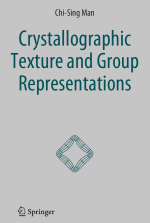Добрый день, Коллеги. Важное сообщение, просьба принять участие. Музей Ферсмана ищет помощь для реставрационных работ в помещении. Подробности по ссылке
Crystallographic texture and group representations / Кристаллографическая текстура и групповые представления
Many materials are polycrystalline aggregates of tiny crystallites or grains of various sizes and shapes. Even for aggregates whose crystallites are chemically identical, the crystal lattices of the grains will still differ in their orientation in space. Since each crystallite is anisotropic in its physical properties, the macroscopic properties of a polycrystal will likewise be anisotropic unless the orientations of its constituent crystallites are completely random and the anisotropies of the crystallites even themselves out. Manufacturing processes (e.g., annealing and hot/cold rolling in the case of sheet metals) and natural processes (e.g., deformation of the earth’s interior during the earth’s long history), however, impart crystalline materials thus formed with crystallographic texture (i.e., the constituent crystallites have preferred orientations), which is found in metals, ceramics, polymers, rocks, and mineralized biological materials. While it does not need much imagination to speculate that crystallographic texture would play a major role in accounting for the anisotropy of physical properties of polycrystalline materials, to ascertain the quantitative relations between texture and anisotropy is an entirely different matter. In fact, it was not until the mid 1960’s that quantitative texture analysis began to take shape as an exact science. Great advances in the subject have been made since then. Nowadays, “texture research is indeed a wide multidisciplinary field” that “connects many domains of science with metallurgy, ceramics, polymer science, geology, geophysics, and biology as just a few highlights”, as Wenk and Van Houtte [338] assert in the conclusion of their 2004 review paper on texture and anisotropy. To their assertion, we may add that more recently crystallographic texture is a basic ingredient in some studies on microstructure-sensitive design to optimize engineering performance of polycrystalline materials (see, e.g., [3, 122, 189, 191]). <...>




